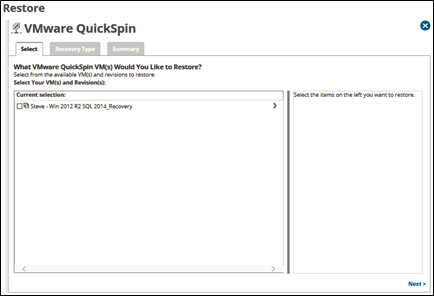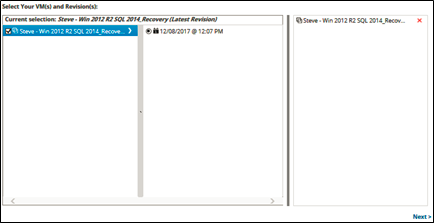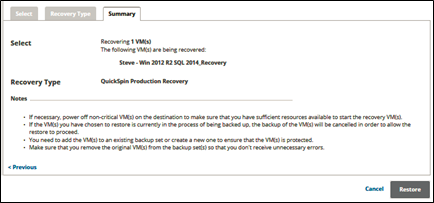This chapter includes the following topics:
- Overview
- Restoring VMware QuickSpin Backups
Overview
VMware QuickSpin restores are speedy because the recovery VMs are standing by locally at the customer’s site, ready to be started to replace their disabled production counterparts.
VMware QuickSpin creates a recovery VM on a local vCenter/ESXi host. In addition, with VMware QuickSpin, you can create and update a recovery VM on a host that is in a cluster. See VMware Clusters for more information.
VMware QuickSpin allows you to select VMs running on supported managed and unmanaged ESXi hosts to back up to the customer’s local vault, to the cloud, or both.
A VM cannot be part of more than one VMware Standard backup set or more than one QuickSpin backup at a time. However, a VM can be part of a VMware Standard and a VMware QuickSpin backup set simultaneously.
VMware QuickSpin Recovery Types
While performing the restore procedure, you are prompted to select how to verify and recover your data to the restore destination. The following options are provided:
- Sandboxed Test Recovery
- Production Recovery
Sandboxed Test Recovery is a non-destructive means for you to verify the integrity of your backed-up VMs without affecting normal business operation. Your production VMs remain powered on and operational. The selected recovery VMs are powered on within an isolated VLAN.
Production Recovery performs an instant recovery of your production VMs with selected recovery VMs. If the production VM is still running, it is shut down before powering up the recovery VMs.
Restoring VMware QuickSpin
To restore a VMware QuickSpin backup, perform the following steps.
- Navigate to the Computer page. See Navigating to the Computer Page for instructions.
The Computer page is displayed.
Click the Restore tab.
The Restore Selections page is displayed.
Click VMware QuickSpin.
The Select page is displayed.
In the Current Selection pane, select the VMs and revisions to be restored.
Clicking the arrow at the right of the VM displays more revisions of the VM.
at the right of the VM displays more revisions of the VM.
Your selection is displayed in the right pane. Click the remove icon to remove any selections or clear the item check box.
to remove any selections or clear the item check box.
Click Next.
The Recovery Type page is displayed.
Select a Recovery type radio button.
If you select Sandboxed Test Recovery (default option):
The source/production VMs are not shut down.
The recovery VMs selected are started on their own separate VLAN to avoid conflicts with the production VMs.
Backups to the recovery VMs do not continue if the recovery VMs are powered on.
If you select Production Recovery:
The source/production VMs are shut down.
The recovery VMs selected are started on the production network. They assume the role of the original production VMs.
Backups to the recovery VMs do not continue if the recovery VMs are powered on.
Click Next.
The Summary page is displayed.
Note: For this example, the Production Recovery option is displayed.
Notes:
If necessary, power off non-critical VMs at the destination so enough resources are available to start the recovery VMs.
If the VMs selected for restore are currently being backed up, the backup of the VMs are canceled to allow the restore to proceed.
Verify your selections, and then click the Restore button.
If you selected Production Recovery at the Destination page, then the following confirmation pop-up is displayed.
By checking the checkbox and selecting Yes, the currently running Production VM(s) are shut down and replaced by the VMware QuickSpin VMs you have selected to restore.
Click the Yes, restore the selected VM(s) check box, and then click Yes.
If you selected Sandboxed Test Recovery at the Destination page, then the following confirmation pop-up is displayed.
Click Yes.
The Restore Selections page is displayed with the latest restore.
Add the Recovery VMs to an existing backup set or create a new one to ensure that the newly recovered VMs are protected.
Remove the original Production VMs from the backup sets to avoid unnecessary errors.
